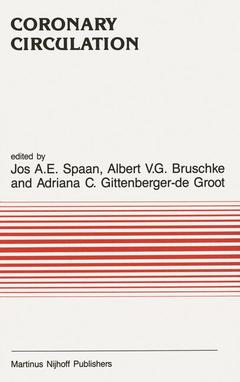Coronary Circulation, Softcover reprint of the original 1st ed. 1987 From basic mechanisms to clinical implications Developments in Cardiovascular Medicine Series, Vol. 79
Langue : Anglais
Coordonnateurs : Spaan J.A., Bruschke A.V., Gittenberger-de Groot Adriana C.

Few diagnostic methods in Cardiology have heralded such revolutionary developments as the introduction of coronary arteriography. When, in the early 1960's, Dr. F. Mason Sones demonstrated that visualization of the coronary anatomy in living humans was not only feasible but sufficiently safe and reliable to be used as a clinical tool in the evaluation of patients with known or suspected ischemic heart disease, the thus far somewhat neglected area of coronary circulation became the focus of interest. Naturally, for a considerable period of time a great deal of emphasis was placed upon coronary anatomy. Simple relations between narrowing lesions, impediment to flow, and prognosis were assumed to exist. Spectacular results of surgical coronary revascularization seemed to confirm this concept. Gradually it has become evident that the pathophysiology of coronary artery disease is considerably more complex. Diagnostic methods were introduced to assess and quantify exercise-induced myocardial ischemia. At first, these tests were used mainly to achieve a more discriminative selection of candidates for coronary arteriography and the coronary arteriogram remained the gold standard. Currently, these techniques have evolved to the point where they provide valuable functional and metabolic information. They have become powerful independent tools in clinical investigations and evaluation of individual patients.
I Coronary anatomy.- Microanatomy of the coronary circulation.- Anatomy and pathology of small coronary arteries.- Anatomy and pathology of large coronary vessels.- Aspects of normal and abnormal development of the main coronary arteries.- II Myocardial perfusion.- Local control of coronary flow.- The extravascular resistance.- Coronary blood flow control and heterogeneous oxygenation of tissue.- Myocardial micro-circulation in the beating heart / in vivo microscopic studies.- Changes in myocardial blood flow and myocardial function are not necessarily unambigously related.- Local myocardial perfusion monitored by electrical resistivity - an exploratory technique -.- III Clinical assessment of myocardial perfusion.- Quantitative digital angiographic techniques.- Metabolic consequences of myocardial underperfusion.- Evaluation of myocardial blood flow with radionuclide techniques.- Myocardial perfusion assessed by nuclear magnetic resonance.- Coronary arterial flow measurements by doppler techniques.- IV Myocardial reperfusion.- Metabolic aspects of myocardial reperfusion.- Right ventricle — coronary artery fistulae and interruption of the left anterior descending coronary artery in patients with pulmonary atresia and intact ventricular septum without operation or shunt only.- Present problems and new issues in coronary artery surgery: an update.- Thrombolysis with and without PTCA in acute myocardial infarction.- Laser angiosurgery: a brief overview of tissue micromachining with spectral diagnostics.
Date de parution : 02-2012
Ouvrage de 260 p.
15.5x23.5 cm
Thèmes de Coronary Circulation :
Mots-clés :
Evaluation; PTCA; anatomy; assessment; circulation; diagnostics; heart; thoracic surgery
© 2024 LAVOISIER S.A.S.



